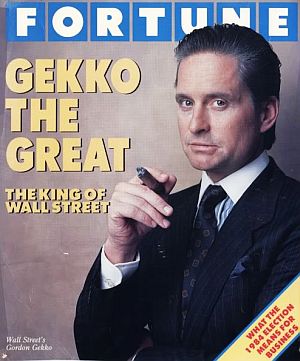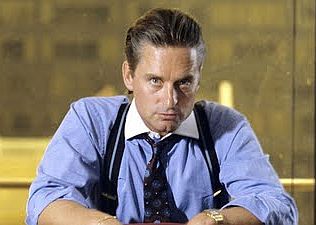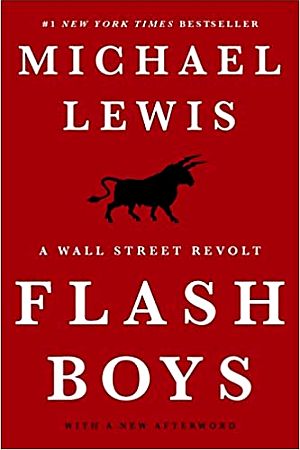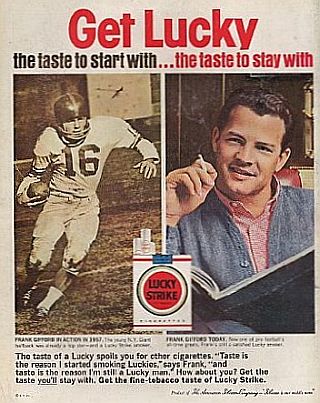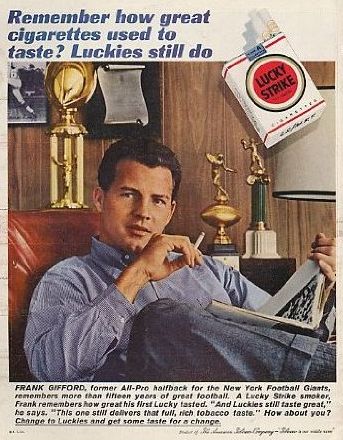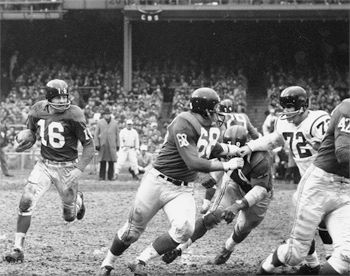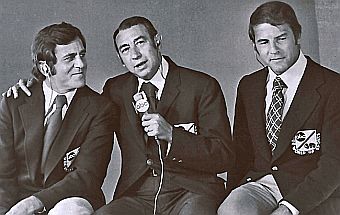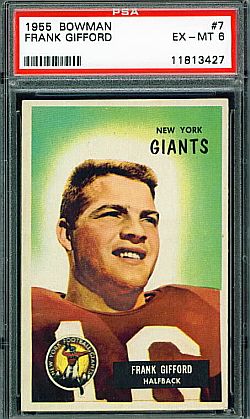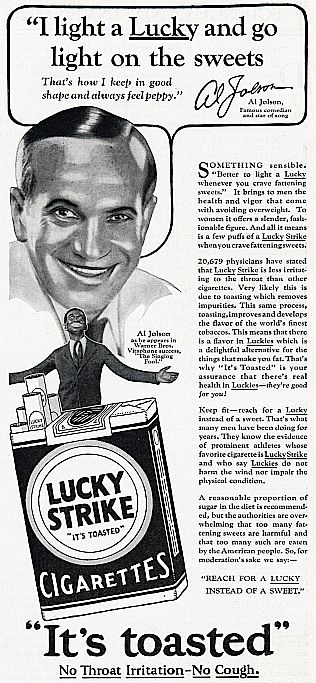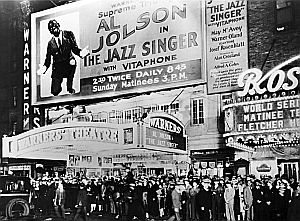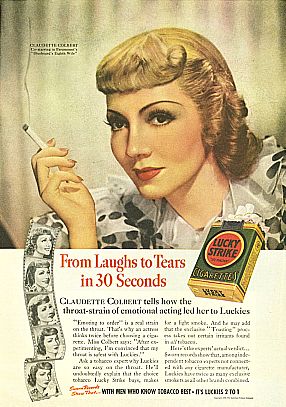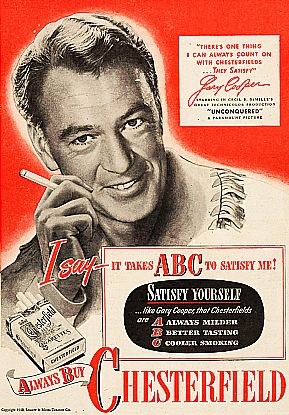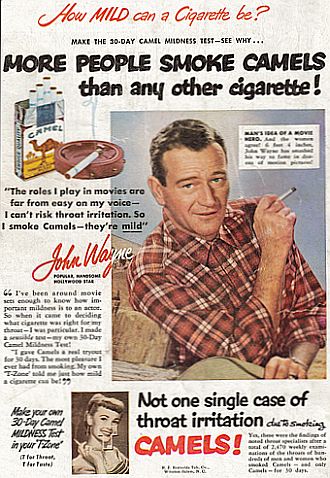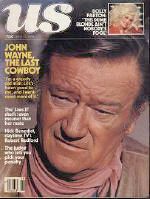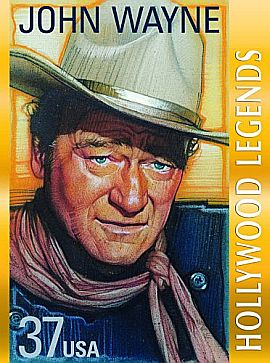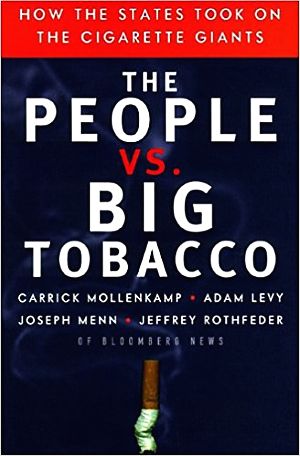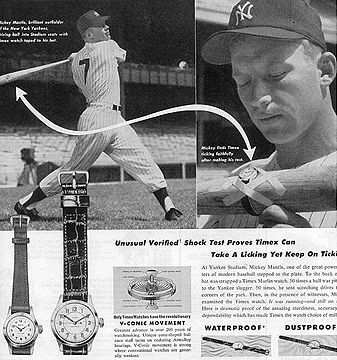 Close-up portion of full-page 1953 ad for a ‘torture tested’ Timex watch taped to Mickey Mantle’s baseball bat.
Close-up portion of full-page 1953 ad for a ‘torture tested’ Timex watch taped to Mickey Mantle’s baseball bat. In the 1950s and 1960s, Timex, a brand-named wristwatch, became something of an iconic American product through a long-running advertising campaign that used celebrities to pitch the product. Print ads, such as the one at right with New York Yankee baseball star, Mickey Mantle, were featured in the major magazines of the day. They showed Timex watches being subject to various kinds of “torture tests” to demonstrate their durability, shock resistance, and/or superior waterproofing. In the ad at right, the watch was taped to Mantle’s bat as he took batting practice.
The Timex “torture test” advertising was also used in TV ads, a series made popular by celebrity newscaster John Cameron Swayze who hosted the spots. A number of these ads also featured sports celebrities who doled out the tough treatment to the watches and/or supplied an endorsing statement. Swayze also hosted non-celebrity Timex ads in which the watch would be subject to other trials — whether placed in a washing machine or attached to the bow of a speed boat. Swayze had made a name for himself as a broadcaster and became a trusted national personality and a believable pitchman for Timex. For over 20 years — well into the 1970s — Swayze appeared in the advertising series with one kind of Timex watch or another being subject to various physical challenges to prove their durability, shock resistance, and/or superior waterproofing.
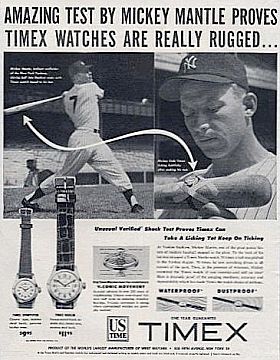 Full page layout of Mickey Mantle ad.
Full page layout of Mickey Mantle ad. In the Mickey Mantle print ad, for example, the full-page version, shown at left, starts off with the following headline:
“AMAZING TEST BY MICKEY MANTLE PROVES TIMEX WATCHES ARE REALLY RUGGED…”
Two photographic panels then show Mantle in action swinging his bat, with one close-up of the barrel of the bat with the Timex watch taped to it. Then the ad’s text and a smaller headline run below the photos:
“Unusual Verified Shock Test Proves Timex Can Take a Beating Yet Keep on Ticking”
“At Yankee Stadium, Mickey Mantle, one of the great power hitters of modern baseball stepped to the plate. To the back of his bat was strapped a Timex Marlin watch. 50 times a ball was pitched to the Yankee slugger. 50 times, he sent scorching drives to all corners of the park. Then, in the presence of witnesses, Mickey examined the Timex watch. It was still running — and still on time! Here is dramatic proof of the amazing sturdiness, accuracy and dependability which has made Timex the watch choice of millions.”
Timex Origins
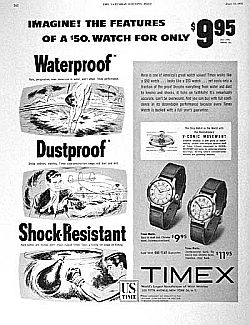 Full-page Timex ad touting its watches in the ‘Saturday Evening Post,’ 1953.
Full-page Timex ad touting its watches in the ‘Saturday Evening Post,’ 1953. Timex is an American watch company with roots that date to 1854 and the Waterbury Clock Company that began in Connecticut’s Naugatuck Valley. Waterbury became known as the “Switzerland of America” during the 19th century. Its sister company, Waterbury Watch, manufactured the first inexpensive pocket watch in 1880. By World War I, Waterbury began making wristwatches, which were just then becoming popular. In the 1930s, Waterbury became known for creating the first Mickey Mouse clock with Mickey’s hands pointing to the time.
During World War II, Waterbury Clock became U.S. Time Company and following the war, in 1950, it introduced the Timex wristwatch. At first, jewelers resisted carrying the watch because of its low 50 percent mark-up, as other brands offered 100 percent mark-ups. U.S. Time Co. then went elsewhere with its watches, setting up displays in drugstores, department stores, and cigar stands — mechanical displays that dunked a ticking watch into water and banged it with a hammer. Then the company began its magazine advertising, stressing its product’s durability, shock resistance, and waterproofing. Consumers soon began buying the watches. By 1951, the company had produced almost 2 million, gaining an 18 percent share of the low-priced U.S. wristwatch market.
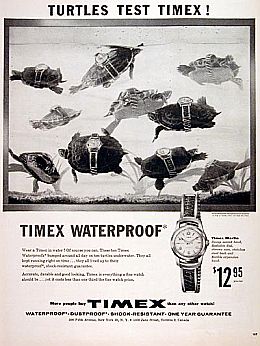 1950s’ print ad showing turtles ‘testing’ Timex watches – ‘banged around all day on ten turtles underwater. They all kept running right on time...They all lived up to the waterproof, shock-resistant guarantee...’
1950s’ print ad showing turtles ‘testing’ Timex watches – ‘banged around all day on ten turtles underwater. They all kept running right on time...They all lived up to the waterproof, shock-resistant guarantee...’ Then in 1952-54, the company began a more focused advertising campaign, first with print ads using the torture tests — a la Mickey Mantle, race horses, swimming turtles, and more. Shortly thereafter, in 1956, it teamed up with spokesman John Cameron Swayze to do TV advertising, and sales took off. The company later became the Timex Corporation, then the Timex Group. To date, Timex has sold over one billion watches. But it was in the 1950s that the brand established itself, and in no small part due to its celebrity-assisted, “torture test” advertising, using the famous line, “It takes a licking and keeps on ticking.”
What made Timex watches so durable was their design and inner workings. Technically, the watch employed a special escapement which had a cone-shaped balance staff that rotated in bearings made of a very hard alloy called “Armalloy.” The balance staff is the most delicate component in a watch, the part most likely to be displaced by a jolt. Timex made theirs sturdier, which greatly enhanced the watch’s shock-resistance. In addition, the Timex movement had fewer parts than other watches, making it even more durable. The Timex watch was also priced right — with 1950s prices ranging initially from $6.75 to $7.95, then $9.95 to $12.95. And the watches kept reasonably good time, off only by a minute or two a day, according to one 1950s’ estimate. Consumers loved them, and they snapped them up in the millions.
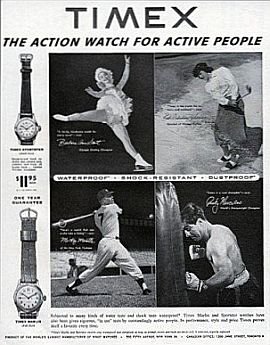 Timex magazine ad of 1954 showing four sports stars who tested and/or endorsed Timex watches.
Timex magazine ad of 1954 showing four sports stars who tested and/or endorsed Timex watches. One round of ads in the print series appearing in 1954 featured sports stars in addition to Mickey Mantle. Ben Hogan, a top professional golfer in the 1950s, was also featured in some Timex ads during this period (see below, later), as was professional boxer Rocky Marciano, shown below in a separate ad. The Timex print ads also included female athletes putting the watch through its paces.
In the ad copy at right — with a headline billing Timex as “The Action Watch for Active People” — four panels show a selection of athletes who tested the watches. In ad’s top half, skater Barbara Ann Scott is shown in the left photograph, and golf star, Babe Didrikson at right. Scott won North American, World and Olympic figure skating honors between 1945 and 1948 and was the first female to land a double lutz when she was 13.
Didrikson, a phenomenal Olympic track star in the 1930s, later turned to a successful career in professional golf. Scott and Didrikson, like Mantle and Marciano who are also shown here, were featured in separate magazine ads as well as this composite.
 Saturday Evening Post ad, June 1954, featuring Rocky Marciano.
Saturday Evening Post ad, June 1954, featuring Rocky Marciano.
Rocky’s Ad
One version of the Rocky Marciano ad appeared in the Saturday Evening Post of June 1954. Marciano was then the World Heavyweight Boxing Champ. In the ad, the headline and text ran as follows:
The Watch ‘The Rock’ Couldn’t Stop!
“The Timex Waterproof Marlin rides Rocky Marciano’s smashing, jolting punches on the body bag, the rapid, bouncing blows in the light bag, then a hot and cold shower. At the end of this workout, Rocky checked and said: ‘Still running, and right on time. It’s true that Timex takes a licking and keeps on ticking — a true champion’.”
Then in 1956, Timex moved its torture-test advertising campaign to television, teaming up with John Cameron Swayze.
|
John Cameron Swayze
The News & Timex
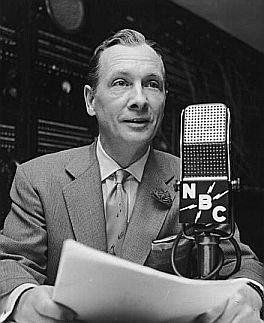 John Cameron Swayze, NBC Radio. John Cameron Swayze, NBC Radio. Swayze was born in Wichita, Kansas in 1904. He aspired first to the Broadway stage and had attended drama school in New York, but in the late 1920s and early 1930s, the dismal economy foreclosed acting possi- bilities. He threw in his lot as a newspaper reporter, working in Kansas City, shortly becoming a radio broadcaster there. He then moved to Hollywood in 1944 landing a desk job with NBC’s Western News Division. In 1947 the network moved him to New York, where Swayze proposed a radio quiz program, Who Said That, in which a panel tried to identify people behind a famous quote. NBC liked the idea and so did his listeners. NBC later appointed Swayze to moderate their televised coverage of the 1948 Republican and Democratic national conventions — the first ever such coverage. The following year he became one of the first “news anchormen,” hosting the Camel News Caravan, a 15-minute news program sponsored by Camel cigarettes that was broadcast five times a week on NBC ( later sponsored on alternating nights by Plymouth automobiles, called the Plymouth News Caravan).
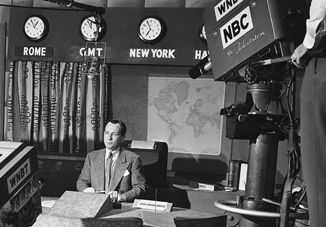 John Cameron Swayze in TV news studio, 1949. John Cameron Swayze in TV news studio, 1949.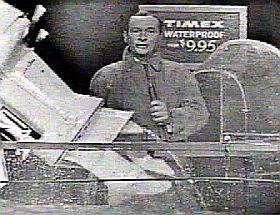 Swayze at torture test with outboard motor. Swayze at torture test with outboard motor. |
Swayze & Timex
The Timex TV ads — with Swayze setting up the action and reporting on the results — showed Timex watches being strapped to the propeller of an outboard motor, taped to a lobster claw in an underwater tank, or being held fist-first by a famous Acapulco cliff diver going head first into the sea from high cliffs. In these action spots, Swayze would retrieve the watch after the test and show it close up, or the camera would otherwise zoom in on the watch after its torture so viewers could see the sweep hand moving over the watch face. Swayze at that point would typically add something like: “Incredibly, the watch is still working after taking that pounding — Timex takes a licking and keeps on ticking.” Americans loved the ads, and many wrote in by the thousands, suggesting new ways to torture the Timex pieces. One Air Force sergeant even offered to crash a plane while wearing a Timex watch. But the torture tests were selling those watches. By the end of the 1950s, one out of every three watches bought in the U.S. was a Timex.
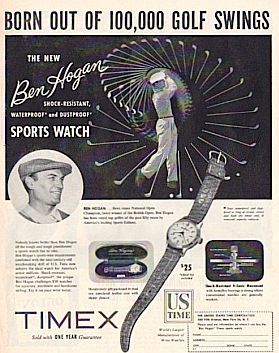 1950s Timex ad with pro golfer, Ben Hogan.
1950s Timex ad with pro golfer, Ben Hogan. Among other tortures that Timex watches endured and survived in these demonstrations were the following: being placed in a paint mixer, frozen in an ice cube tray, spun in a vacuum cleaner, placed on the leg of a race horse, attached to ice skater’s boot above the blade (see video above ), tossed over the Grand Coulee Dam, attached to an archer’s arrow tip that was shot through a pane of glass, attached to the blade of an outboard motor, strapped to a tackle line and cast off a deep-sea fishing boat, attached to the pontoon of a plane that landed on water in Hawaii, and swallowed by a farmer’s cow in Texas.
However, there was one reported incident of an elephant crushing a Timex — when a board with a Timex affixed to its underside was stood upon by the elephant in a one-leg pose.
In most of the tests — some done live — Swayze was always his buoyant self and rarely at a loss for words, filling in with appropriate banter when need be — as he did when one Mexican cliff diver was being banged around in rough surf after completing his dive with a Timex. In another live commercial, broadcast in 1958 during The Steve Allen Show, a watch that had been fastened to the blade of outboard motor being run in a stage tank, came off during the test and Swayze could not retrieve it. “Without missing a beat,” explains New York Times writer, Randy Kennedy, Swayze reported that the watch was probably “still ticking” at the bottom of the tank.
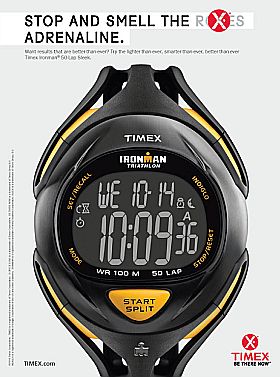 Timex ads in more recent years have sought a hipper image, with various plays on one’s use of time, here for the Ironman triathlete type (2009). Click for Ironman watch.
Timex ads in more recent years have sought a hipper image, with various plays on one’s use of time, here for the Ironman triathlete type (2009). Click for Ironman watch. In May 1960, Swayze and Timex received some special exposure when three Timex TV ads ran on the much-watched
Frank Sinatra Timex Show — Welcome Home Elvis. That show starred
Sinatra and his “Rat Pack” group of friends and entertainers who were welcoming Elvis Presley back from his stint in the U.S. Army. In one of the ads during that show, Swayze stood by as the dolphin “Nellie” tested the watch in a series of jumps at Marine World in Florida. Timex, meanwhile, continued to do well in sales, and was soon at the top of the U.S. and world markets. By 1963, nearly half the watches sold in the U.S. were from Timex. By 1967, it was the world’s best-selling watch brand.
In the 1970s, the American watch and clock industry was devastated by the arrival of cheap mechanical watches from the Far East, as well as the development of digital quartz watches pioneered by the Japanese. Timex survived the 1970s and 1980s and began a comeback. It phased out mechanical watch production in favor of digital watches and also introduced new lines. In 1986, its “Ironman Triathlon” watch, jointly devised by athletes and industrial designers, became America’s best-selling watch, later adding a full line for men and women to become the world’s largest selling sports watch well into the1990s. Timex remains profitable and competitive today, although its primary market remains the U.S. and Canada. The company sells a number of other brands such as Guess, Nautica, Ecko, Opex and is also in the luxury watch market with Versace. It also manufactures the Timex Datalink series of PDA-type watches, GPS-enabled watches, heart rate monitor exercise watches, and other high-tech devices.
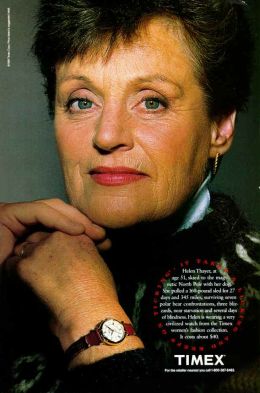 1991 Timex ad touting survival abilities of its wearer and the ‘keeps-on-ticking’ slogan in red lettering that encircles description, below. Click for ladies watches. 1991 Timex ad touting survival abilities of its wearer and the ‘keeps-on-ticking’ slogan in red lettering that encircles description, below. Click for ladies watches. |
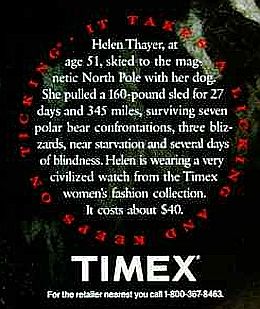 1991 Timex watch ad description of Helen Thayer. 1991 Timex watch ad description of Helen Thayer. |
“Ticking” in 1990s
John Cameron Swayze and his Timex ads, meanwhile, remained a staple of the company’s TV advertising through the mid- to-late-1970s, then being phased out. However, in 1989, about a decade after the ads had ceased, Timex decided to bring back the famous slogan — and also Swayze’s recorded voice — to use in some newer TV ads. Swayze at the time was then in his 80s. Timex desperately wanted to modernize its image at the time and not return to the past. However, research convinced Timex otherwise, showing that baby boomers who grew up with the ads had a fondness for them and remembered Swayze and the lines. Timex asked 2,000 consumers what they remem- bered most about the watch maker. “Just about everyone said, ‘It takes a licking and keeps on ticking’,” said Timex advertising manager Ron Sok in 1989. “Keep in mind, we hadn’t used that slogan in our ads for 10 years.”
So Timex dusted off its old slogan, added some funny plot lines, and launched their new TV ads for 1989-1990. One featured Timex watches strapped to the bellies of Sumo wrestlers — with the watches surviving. Another showed a psychic with mind power that could bend a fork, but couldn’t stop a Timex watch. A third had an opera singer’s shrill voice shattering every object in the opera hall — except the Timex watch. And at the end of each of these ads came Swayze’s voice assuring the viewers that, indeed, Timex watches “keep on ticking.” In print ads too, Timex featured individuals who endured /survived rugged physical challenges — i.e., took a licking, but kept on ticking — as shown in the 1991 sample ad at right. But in these ads, Timex also found a way to keep using its venerable slogan, “it takes a licking and keeps on ticking,” printed in red to encircle the descriptive ad copy.
Timex has since revamped its advertising strategy a few times, using newer and hipper themes — though departing from its classic slogan with some trepidation. In 2003 or so, it tried “Timex: Life is Ticking” and more recently it has used, “Timex: Be There Now,” as in the ad sample for the Ironman watch shown above earlier. Still, in the pantheon of memorable advertising, the “keeps on ticking” line remains one of the top rated ad campaigns — ranked No. 40 by Advertising Age on its list of the top 100 campaigns of the 20th century. The classic Timex campaign of the 1950s and 1960s is also a good example of the use of novelty action and celebrity association in advertising.
To see additional stories on advertising at this website, go to the “Madison Avenue” page. See also, “Athletes Advertising,” a topics page with additional choices in that category, or go to the “Annals of Sport” page or the “TV & Culture” page for further story choices. Thanks for visiting — and if you like what you find here, please make a donation to help support the research and writing at this website. Thank you. — Jack Doyle
______________________________
Date Posted: 17 August 2009
Last Update: 27 May 2018
Comments to: jdoyle@pophistorydig.com
Article Citation
Jack Doyle, “…Keeps on Ticking, 1950s-1990s,”
PopHistoryDig.com, August 17, 2009.
______________________________
Sources, Links & Additional Information
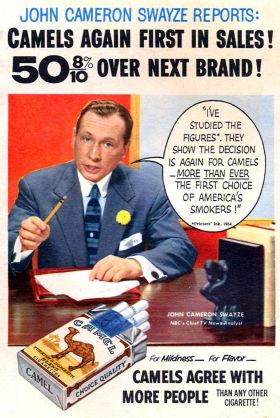 John Cameron Swayze also did advertisements for Camel cigarettes in the 1950s, as Camel sponsored his news show. In that day, however, celebrities of all stripes -- actors, TV personalities, even sports stars -- did tobacco ads. John Cameron Swayze also did advertisements for Camel cigarettes in the 1950s, as Camel sponsored his news show. In that day, however, celebrities of all stripes -- actors, TV personalities, even sports stars -- did tobacco ads. |
 Timex also sponsored popular TV shows, touting its sponsorship in advertising, as in this 1957 ad for 'The Bob Hope Show'. Timex also sponsored popular TV shows, touting its sponsorship in advertising, as in this 1957 ad for 'The Bob Hope Show'. |
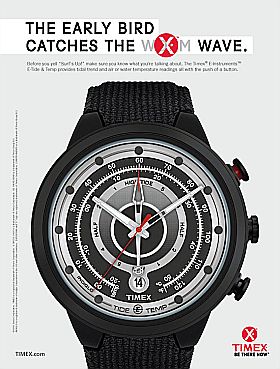 More recent Timex ad: ‘Before you yell ‘Surf’s Up!’ make sure you know what you’re talking about. The Timex E-Instruments E-Tide & Temp provides tidal trend and air or water temperature readings all with the push of a button.’ Click for Timex watches. More recent Timex ad: ‘Before you yell ‘Surf’s Up!’ make sure you know what you’re talking about. The Timex E-Instruments E-Tide & Temp provides tidal trend and air or water temperature readings all with the push of a button.’ Click for Timex watches. |
“Amazing Test by Mickey Mantle Proves Timex Watches Are Really Rugged,” Timex Adver- tisement, Saturday Evening Post, various dates, 1953-1954.
“John Cameron Swayze,” Wikipedia.org.
“Timex History and Vintage Timex Watch Com- mercials,” RyanRooney.com.
“Corporations: Watches For an Impulse,” Time, Friday, March 15, 1963.
“Timeline,” TimeExpo, The Timex Museum.
Rocky Marciano, in full-page advertisement for Timex Watches at training camp, Saturday Evening Post, June 1954.
Isadore Barmash, “The Mainspring of Timex; Lehmkuhl Pins Hope On Quartz Watches,” New York Times, Sunday, December 5, 1971, Business & Finance, p. F-7.
Randall Rothenberg, The Media Business: Advertising, “Some of Those Slogans Just Keep On Ticking,” New York Times, Friday, December 9, 1988.
Bruce Horovitz, “It’s Commercial ‘Deja Vu’ As Old Ad Slogans Become the Latest Thing,”Los Angeles Times, September 19, 1989.
Brian Jenkins, “John Cameron Swayze Dead at 89,”CNN, August 16, 1995.
Randy Kennedy, John Cameron Swayze, 89, Journalist and TV Pitchman,” New York Times, August 17, 1995.
“Top 100 Advertising Campaigns: The Advertising Century,” AdAge.com, (Advertising Age maga- zine), viewed, August 16, 2009.
Timex Torture Test TV Ad (1950s), “Extreme Cliff Diving,” Timex TV Ad with John Cameron Swayze featuring Champion Cliff Diver, Raoul Garcia at the La Perla Cliffs, Aculpulco, Mexico, on You Tube. (2:23 minutes).
Timex Torture Test TV Ad (1960), “Nellie The Dolphin,” Timex TV Ad with John Cameron Swayze at Marine World, Florida, on You Tube (2:05 minutes)
Timex Torture Test TV Ad (1971), “Champion Skater,” at Sun Valley, Idaho with John Cameron Swayze,on You Tube. (1:30 minutes)
Timex Torture Test TV Ad, “Archer’s Arrow Through Pane of Glass,” Timex Ad with John Cameron Swayze on You Tube (1:49 minutes)
Barbara Matusow, The Evening Stars, New York: Houghton-Mifflin Co.,1983.
Jeff Alan, Anchoring America: The Changing Face of Network News , 2003, 426pp.
Stuart Elliott, The Media Business, “Advertising: ‘Takes a Licking and Keeps on Ticking’ Is On The Way Out at Timex. Now, it’s ‘Life is ticking’,” New York Times, August 26, 2003.
1955 TV Newscast With John Cameron Swayze (Sample 1), Plymouth News Caravan of April 18, 1955, You Tube ( 8:42 minutes). Note: This early TV newscast bears little resemblance to today’s more sophisticated product, but it does show the early origins of TV news and format. Stories covered in this example include the death of Albert Einstein and some earlier statements by Einstein on camera. Also includes commercials.
1955 TV Newscast with John Cameron Swayze, (Sample 2), Plymouth News Caravan of April 21, 1955 (14+ minutes). Plymouth News Caravan alternated with Camel News Caravan on Tuesday and Thursday nights, 7:45-8pm, Eastern Time.
Timex Website, “As Advertised In.”
Camel Newsreel Theatre, A 10-minute Fox/ Movietone Newsreel Narrated Off-Screen by John Cameron Swayze February 1948 – February 1949.
Camel News Caravan, A 15-minute Televised Newscast Hosted by John Cameron Swayze, February 1949 – October 1956.
